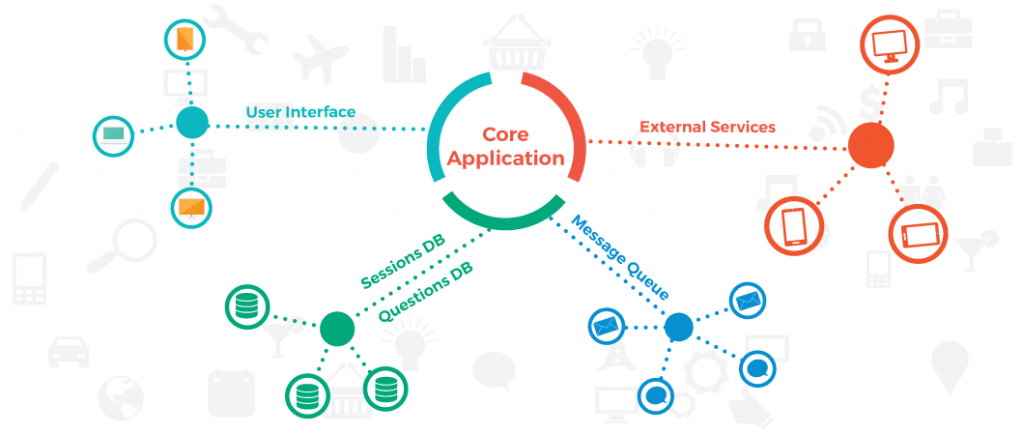Last updated on March 25th, 2021
Today organizations are driven to increase their velocity of production and deliver quality products in the minimum possible time… Software products are in a continuous stage of progress and evolution…Frequent product updates and upgrades have become the norm in order to maintain competitive advantage and remain ahead of the curve… There are more products being built on the cloud than before for better scalability and cost effectiveness… To enable all of this, organizations realize that they need to move away from a monolithic architecture and adopt a new architecture that gives them more flexibility, scalability, increased efficiencies and cost effectiveness. Enter, the age of microservices.
So what essentially is a microservices architecture?
It can easily be said that the growth of technologies such as cloud computing and big data and adoption of agile development practices are some of the main reasons for the rise of microservices. Microservices is an architecture that helps organizations create decoupled and independent processes and services which are easier to deploy and manage. Unlike a monolithic architecture with heavy inter-modular dependencies, fewer releases and scalability challenges, microservices separates the application into smaller parts that are more composable, scalable and manageable. The application developed using Microservices essentially is the sum of all these independently developed components, that speak freely to each other and deliver great functionality.
There are some features that are very specific to microservices. These are:
- Clearly demarcated stateful and stateless services that allow the microservices application to scale better and provide a persistence layer.
- In microservices, every piece of knowledge has a single, authoritarian and unambiguous representation and does not share dependencies and hence does not share libraries or SDK’s
- Each service in a microservice application is designed with a specific task in mind and has a well-defined boundary.
- Microservices use lightweight messaging protocol for communication and can use both synchronous or asynchronous channels to talk.
Microservices – the benefits
Jeff Kaplan, managing director of THINK strategies Inc. says, “If you are not continually improving your application, then your business is falling behind the competition,” “By architecting a large application or system as a series of very small microservices, it becomes much easier to update specific aspects and innovate.”
While it might seem that the main aim of microservices is to aid agile application development and deployment, its main benefit lies in the flexibility it provides businesses to be transformative in nature and stay ahead of their competitors. Microservices allows businesses to become more proactive in nature instead of reactive and gives businesses a chance to accelerate digital transformation and power scalable innovation. Gartner Research estimates that today 51% of enterprises are looking at adopting a microservices architecture because of the following benefits:
- Microservices gives developers the flexibility to build smaller, focused services that are clearly partitioned across functional boundaries to promote developer productivity.
- Developers can use different technology stacks for different functionalities according to the business case or feature requirement as microservices is language agnostic. So, for event-processing microservices, they may use java and Cassandra and for recommendation microservices, they can use python for its machine learning capabilities. Developers have the flexibility to implement each service using a different language, framework or ancillary service. While this might sound challenging to manage services written in different languages for one application, it can easily be done using containers.
- Microservices allows those services that are high in demand to be deployed separately across multiple servers for performance enhancement and ensures that other services do not get impacted due to surges in demand. This enables ease of deployment and resilience.
- Microservices also makes it easier to change and test an application and makes security and regression testing easier and faster as they have smaller code bases that are easy to understand and contain.
- Microservices is designed to work in a cloud environment and hence interact differently with the IT infrastructure with the help of automation.
- Microservices architecture also provides system resilience. If one microservice stops working only a small and limited functionality gets affected. This makes it easier to manage and mitigate functionality failures easily.
- Microservices also provides interoperability on security and security mechanisms and support different styles of credentials in an existing implementation and solution.
SOA and Microservices – two sides of the same coin?
While the concept of Microservices might sound similar to Service Oriented Architecture (SOA) these two are not interchangeable concepts. For starters, Microservices is much more light weight when compared to SOA. While Microservices are independently deployable, SOA is implemented in ‘deployment monoliths’ with SOA being more platform driven. In SOA application services provide services to the other components of the application. In Microservices, however, each component or service is an independently deployed feature or service. While many might say that “Microservices is SOA’ done correctly, there are many smaller differences that divide these two. However, that is a discussion for another day.



